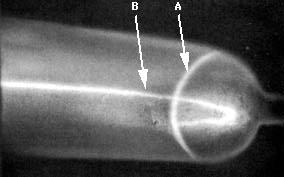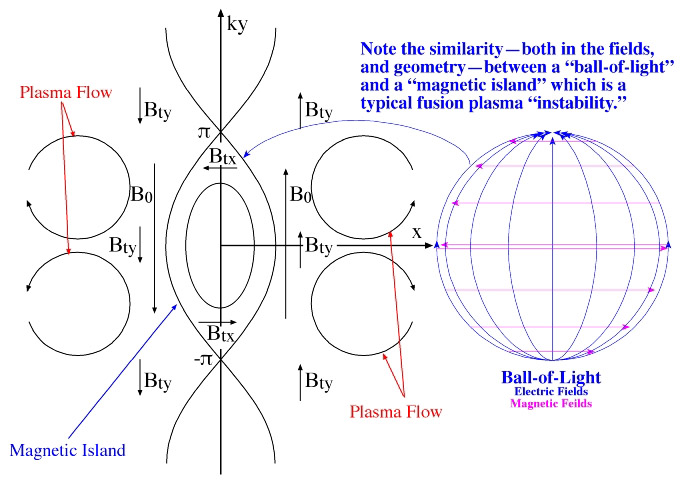(See the video evidence that supports The Ball of Light Particle Model.)
Instabilities in fusion plasmas are very common. There are so many types of instabilities, I will not try to catalog them here at this time. The key issue is every time fusion scientists discover a new "instability" what they are really discovering is their lack of understanding in what is causing the problem. I believe I know what is the most important cause of the majority of instabilities.
If you set up an electrical current through a wire, then a magnetic field will curl around the wire as is shown in the following graphic.
.
If you look at this wire from the right hand end, then the magnetic field would follow compass needles as is shown in the following graphic.

If the compass needles are replaced by iron filings, then they would form a pattern as is shown in the following graphic.

If two wires are placed parallel to each other, with a current running through them in the same direction, then a force will act between the two wires and pull the two wires toward each other as depicted in the following graphic.

You can place a voltage over a sphere as shown in the following graphic.

The sphere is hollow, so the current must flow around the surface of the sphere, rather than straight through the sphere.

Traditional physics implies that the magnetic field would wrap around the sphere in the same direction as the wire in the first graphic above. This is wrong.

The current must spread out -- becoming less concentrated -- over the sphere on the left hemisphere, then come back together -- becoming more concentrated -- on the right hemisphere.

Because this flow becomes less concentrated, and then more concentrated, the magnetic field does not flow in the same direction around both hemispheres. The correct depiction of the magnetic field is shown in the following graphic.

As the current flows through a wire, a center pointing force points towards the center of the wire. This force is described by physicists using the vector S (the Poynting Vector).

Under high current conditions the spherical wave patterns set up within the wire and the Poynting vector starts to form this pattern.

When a large current is passed through a wire -- a current too large for the wire to handle -- the wire will explode. Why?
The spherical waves set up in the will cause the wire to explode with a the following pattern.

If a larger current is passed through the wire, the spherical waves will explode the wire with the following pattern.

Examining the details of the waves in the following graphic...

The current becomes greater at localized nodes in the wire. The temperature at these nodes would be much higher. The mass of the wire would thus be vaporized first at these nodes. The plasma of the vaporizing wire would start to expand away from the wires first from these nodes. The cooler areas of the wire would expand away from the anti-nodes later.
With higher exploding currents, the plasma explodes away from the wire faster. Locally, each little jet of plasma -- moving away from the wire at a right angle -- would create tighter magnetic fields the faster the plasma moves. Thus, under higher currents, the plasma would have sharper points than under lower currents.
Nuclear fusion physicists commonly create fusion plasmas containing in a cylindrical magnetic field. The magnetic field wraps around the plasma just like the magnetic field wraps around the wire in the first graphic above. When a plasma "instability" occurs within the plasma it is due to the spherical magnetic fields setting up within the plasma flow. Note on the left hand hemisphere in the sphere below the magnetic field wraps in an opposite direction to the overall magnetic field wrapping around the plasma. This causes the plasma in this area to quickly reorient creating the instability.

In the graphic below is a typical laboratory plasma undergoing a pinch. At the point where the arrow A is pointing, I believe, the magnetic field starts contracting. To the right of the neck, the magnetic field would naturally try to flip directions.

In the graphic below is how physicists would typically explain the magnetic field orientations. I believe this is incorrect.

I believe the magnetic field orientation for the right hand side of the neck would reverse as shown in the following graphic.

Because of the change in direction of the magnetic field, it can cause the flow of the plasma to start bending as in the following graphic. As soon as this occurs, the it would wreck the plasma stability.

In the graphic below, multiple spherical fields set up at the same time. This would be a very unstable condition in the plasma.

One type of instability in fusion plasma is called a "magnetic island." It is called this because the magnetic fields reorientate themselves to form an island of plasma within the the larger plasma flow.

Note: the left portion of this graphic is similar to Figure 11.3 on page 214 of Plasma Physics by Nishikawa and Wakatani, Third Edition.
To better understand how fusion scientists could use these spherical wave patterns -- "instabilities" -- to their advantage, you can look at the graphics in my fusion patent application.